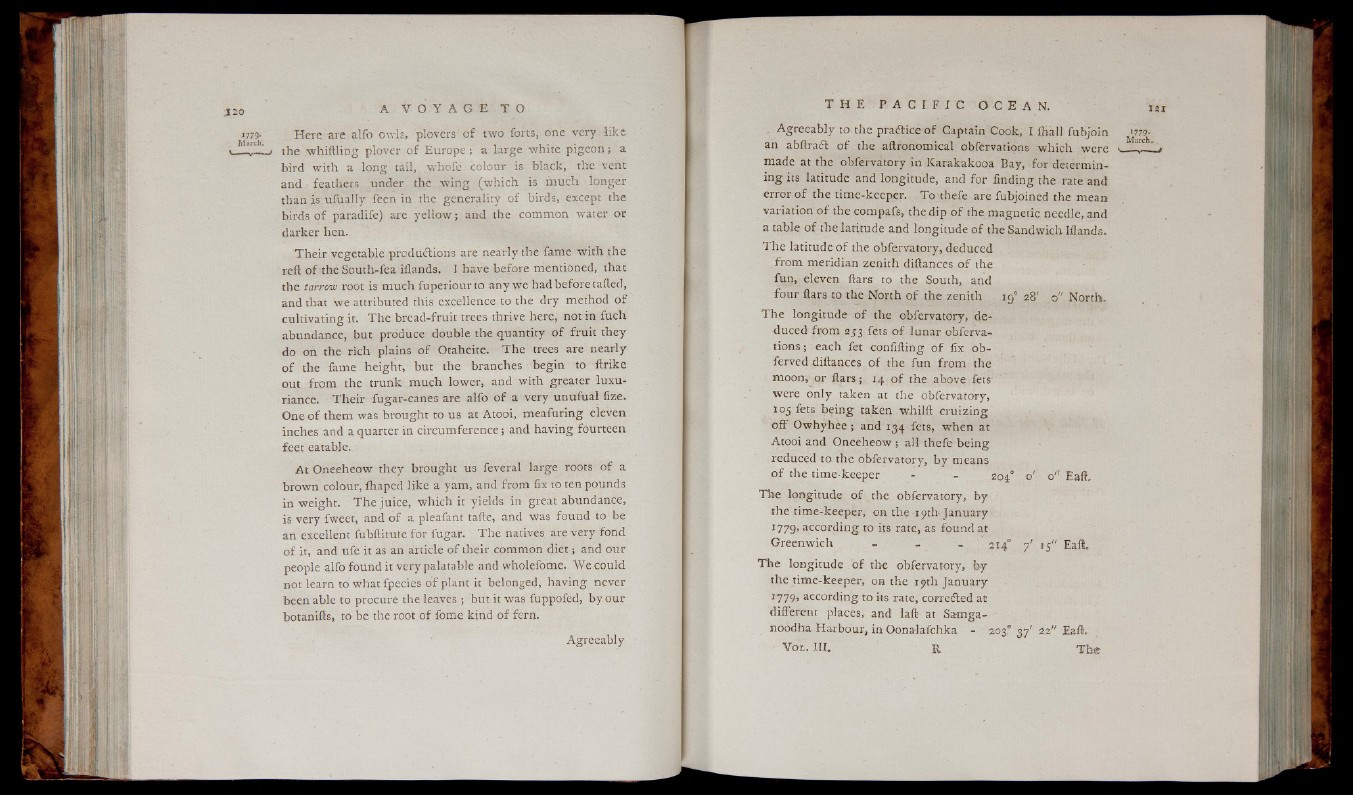
Here are alfo owls, plovers o f two forts, one very lik e
the w hittlin g plover o f Europe ; a large white p ig e o n ; a
bird w ith a lo n g tail, whofe colour is black, the vent
and feathers under the w in g (w hich is much long er
than is u lu a lly feen in the generality o f birds, except the
birds o f paradife) are y e l lo w ; and the common water or
darker hen.
T h e ir vegetable productions are n early the fame w ith the
reft o f the South-fea iflands. I have before mentioned, that
the tarrow root is much fuperiourto any we had before tatted,
and that we attributed this excellence to the dry method o f
cu ltiv a tin g it. T h e bread-fruit trees thrive here, not in fu ch
abundance, but produce double the quantity o f fru it they
do on the rich plains o f Otaheite. T h e trees are n early
o f the fame h e ight, but the branches begin to ftrike
out from the tru nk much lower, and with greater lu xu riance.
T h e ir fugar-canes are alfo o f a very un u fu a l fize.
One o f them was brought to us at Atooi, meafuring eleven
inches and a quarter in c ir cum fe ren ce ; and ha vin g fourteen
fee t eatable.
A tO n e eh e ow the y brought us feveral large roots o f a
brown colour, ihaped lik e a yam, and from fix to ten pounds
in weight. T h e ju ice , w hich it yields in great abundance,
is very fweet, and o f a pleafant tafte, and was found to be
an excellent fubftitute for fugar. T h e natives are ve ry fond
o f it, and ufe it as an article o f their common d ie t ; and our
people alfo found it ve ry palatable and wholefome. We could
not learn to what fpecies o f plant it belonged, h a vin g never
been able to procure the leaves ; but it was fuppofed, by our
botanifts, to be the root o f fome kind o f fern.
A greeably
A gre eab ly to the practice o f Captain Cook, I fliall fubjoin
an abftraft o f the aftronomical observations w h ich were
made at the obfervatory in Karakakooa Bay, for determinin
g its latitude and longitude, and for finding the rate and
error o f the time-keeper. To thefe are fubjoined the mean
variation o f the compafs, the dip o f the magnetic needle, and
a table o f the latitude and longitude o f the Sandwich Iflands.
T h e latitude o f the obfervatory, deduced
from meridian zenith diftances o f the
fun, eleven flars to the South, and
fo u r ftars to the North o f the zen ith 19° 28' o" North.
T h e longitude o f the obfervatory, deduced
from 253 fets o f lun ar obferva-
tio n s ; each fet confifting o f fix ob-
ferved diftances o f the fun from the
moon, or fta r s ; 14 o f the above fets
were on ly taken at the obfervatory,
105 fets b e in g taken whilft c ru iz in g
o f f O w h y h e e ; and 134 fets, when at
Atooi and O n e eh eow ; all thefe be in g
reduced to the obfervatory, b y means
o f the time-keeper - - 204° o' o" Eafl.
Tire longitude o f the obfervatory, by
the time-keeper, on the 19th-January
1779, a ccording to its rate, as found at
G re enwich - - - 214“ 7' 15" Eaft.
T h e longitude o f the obfervatory, by
the time-keeperi on the 19th January
1779, according to its rate, correfted at
different places, and laft at Samga-
noodha Harbour, in Oonalafchka - 203" 37' 22" Eaft.
V0 1. IIL R The